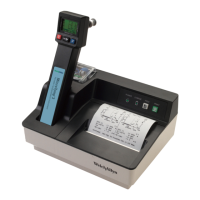Directions for use Interpreting test results 37
Tympanograms with artifact
Conditions which cause artifact:
• Patient movement
• Practitioner movement
• Vocalizing or crying
1000-Hz mode
Tympanometry in young infants
Tympanograms obtained with a 226-Hz probe tone have been found to be insensitive to
middle ear fluid in young infants. Recent studies using a 1000-Hz probe tone have shown
good sensitivity to middle ear disease in this population. Research suggests the age at
which 226-Hz tympanometry becomes an appropriate test is between four and six
months. An appropriate guideline for selecting the appropriate age-based frequency is to
use 1000-Hz tympanometry for infants below four months of age, 226-Hz for infants
above six months of age, and both frequencies for infants four to six months of age.
The “Quick-Interpretation” feature of this tympanometer enables clinicians to test infants
less than six months old and receive immediate interpretive feedback from the device.
The 1000-Hz interpretations are based on proven clinical criteria, including calculated
values in the shape of the curve.
During the typanometric measurement, the clinician should keep a steady hand,
and the patient should not talk, chew gum, yawn, cry, or move. If the display
indicates too much artifact, the clinician must repeat the measurement.
-400 -200 0 200
2
0.5
0
1.0
1
1.5
PRESSURE - daPa
Ya - mmho
Vea
+200
RIGHT EAR
R

